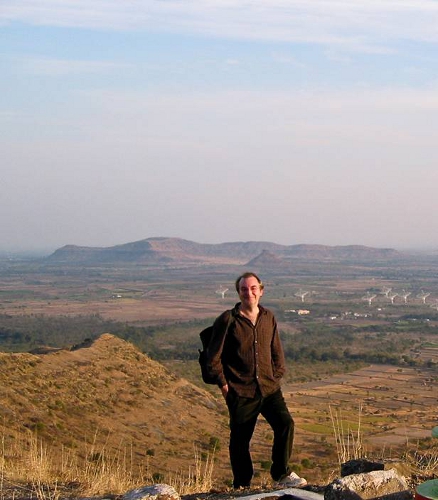 Steven Rawlings. Photo by Katherine Blundell
Steven Rawlings. Photo by Katherine Blundell
Steven Rawlings
Contributed by Katherine Blundell
Steve Rawlings, who died in January 2012, was an outstanding observational cosmologist who made significant contributions to our understanding of radio galaxies and played an important role in developing the case for the Square Kilometre Array (SKA) project. He was born in 1961 and grew up in Worthing in the county of Sussex, UK. During his PhD research at the Cavendish Laboratory in Cambridge he studied giant radio galaxies and quasars, using a variety of astronomical techniques to analyse their radio and optical properties and to determine their distances from the Earth. After a research fellowship at St John's College Cambridge, his undergraduate college, Steve moved to Oxford in 1991 on a research council advanced fellowship. Steve became increasingly interested in the high-redshift universe and greatly enjoyed discovering ever-more distant radio galaxies. His interests in cosmology grew and diversified into other wavebands: X-rays, sub-mm and infrared.
His high success rate in being awarded observing time on the James Clerk Maxwell Telescope and on the United Kingdom Infra-Red Telescope seemed correspondingly matched by a remarkable failure to obtain good weather when he went out to Mauna Kea to use these telescopes - so much so that the correlation of Steve arriving on the mountain with the coincident arrival of overhead clouds became a seemingly well-determined statistical anomaly. Despite these frequent meteorological setbacks, Steve made major contributions to our understanding of distant active galaxies, their gas and dust contents, and especially their evolution across cosmic time. A particular joy for him was the discovery of a radio galaxy that held the record for a number of years for being the most distant one known.
Steve Rawlings brought considerable energy to surveys for yet-fainter objects in the distant universe, in the sub-mm and infrared. He also took pleasure in observing at the Giant Metre-wave Radio Telescope in India (where he is pictured in the accompanying photograph) and his passion for very-low-frequency radio observations motivated his promotion of the ambitious, next-generation radio telescopes such as LoFAR and the SKA.
His skills were deployed in everything from persuasion at political levels, gutsy persistence in galvanizing activity across the UK as the SKA Foundation Board member, and devising simulations of what might be detected by differently designed telescopes, to studies of how to meet the enormous computational challenges the SKA would bring. He was inspired by the scientific goals of these next-generation telescopes: measuring the distribution of hydrogen in the universe since the Big Bang, discerning the nature of the dark energy thought to pervade the universe, measuring the accretion history of the universe, and the influence of radio galaxies on the formation of structures such as galaxies and clusters. He also contributed greatly to studies of the Sunyaev-Zeldovich effect: the imprint on the cosmic microwave background of hot electrons captured in the deep potential wells of clusters of galaxies. Steve Rawlings's creativity in these and many other areas greatly enriched the field, and will have an enduring influence on it.
Steve Rawlings was Head of Astrophysics at the University of Oxford from 2005 to 2010 and during that time especially he did much to encourage and promote research in areas quite distinct from his own. Inside and outside work, Steve was inclusive and supportive and engendered those values in all who interacted with him. He was also great fun: many former students and colleagues around the world will recall playing football or cricket with him. It was definitely a big plus for him, when considering going to a conference, if it listed on its programme a five- a-side football competition.
In common with some 10% of the population, Steve Rawlings suffered from a diagnosed mental illness which, sadly in his case, ultimately led to his death. Out-of-character behaviour that is a manifestation of psychotic mental illness is a painful reality, but those who knew him will remember the real Steve: enjoying a pint of beer, a game of football, and being a down-to-earth and supportive friend.
He was devoted to his wife Linda, whom he married 21 years ago.
![[IAU logo]](iau_wb_thumb.jpg)
![[URSI logo]](URSI-logo-thumb.jpg)
![[Karl Jansky at his antenna]](jansky_photo_02_thumb.jpg)
![[Reber's Wheaton antenna]](Reber_Telescope_Wheaton_thumb.jpg)
![[Dover Heights]](Dover_Heights_02_thumb.jpg)
![[4C telescope]](GB61-195_4C_telescope_thumb.jpg)
![[Ewen and horn antenna]](ewen_horn1s.jpg)
![[Dwingeloo, 1956]](Dwingeloo-1956-thumb.jpg)
![[Jocelyn Bell Burnell and Cambridge antenna used in pulsar discovery]](burnell2_thumb.jpg)
![[Lovell Telescope at Jodrell Bank]](site_1594_0001-500-334-20180316163019-thumb150.jpg)
![[Wilson, Penzias, and Bell Labs horn antenna]](wilson-penzias-horn_thumb.jpg)
![[6-m Millimeter Radio Telescope in Mitaka, Japan]](6m-thumb.jpg)

